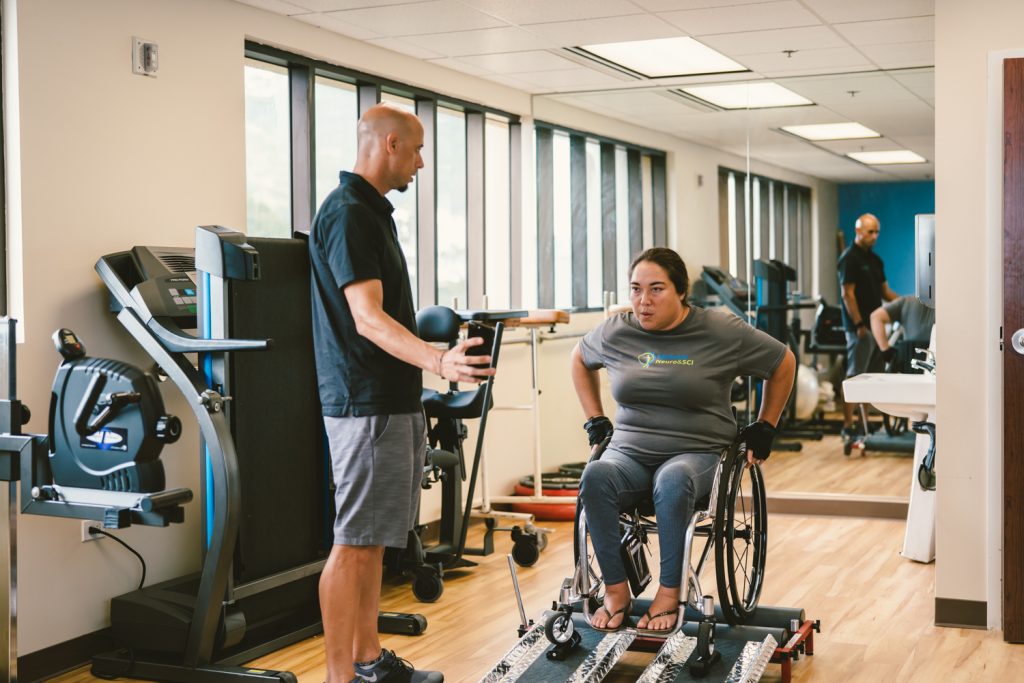A spinal cord injury can be a life-changing experience, but we strive to give hope and maximize recovery. Our treatment approach focuses on functional movements that most people can do every day, such as standing and walking. Our essential aim is to stimulate the paralyzed areas. Combined with a consistent regime of cardiovascular and joint mobility exercises, this provides the best chance for motor/sensory return.
Spinal Cord Injury Recovery

Call now for more info or for a free consultation.
What is Spinal Cord Injury?
Most of us are at least somewhat familiar with spinal cord injuries, whether through movies, books, or someone we know. But while many people are aware that those with sever spinal cord injuries can suffer from paralysis and an inability to walk, we don’t often take time to consider the other physiological and psychological challenges this type of injury can cause.
As it turns out, the inability to walk is only the tip of the iceberg. Other complications of paralysis can include bedsores; numbness and the inability to sense heat and cold; loss of sexual function, bladder function, and bowel function; lost of some breathing function (as much as 50 percent); constant neurological pain; the inability to perform basic tasks, which can limit your independence; and of course the psychological struggles that accompany all of these symptoms.
Of course, not every spinal cord injury results in all of these symptoms. Depending where the injury occurs and how severe it is, patients may suffer all, some, or none of these symptoms. Others may initially experience symptoms that eventually resolve, or that lessen somewhat over time. But regardless of the severity of the injury, trauma to the spinal cord can be extremely frightening, not to mention limiting and life-changing.
Spinal cord injuries can be caused by a wide variety of accidents, but there are a few that are more common than others. Nearly half of all spinal cord injuries (46 percent) are caused by car accidents, while another 22 percent are caused by falls. (Falls are a particular concern for the elderly, who are more prone to falls and often more susceptible to fall-related injuries. Sports injuries and acts of violence make up another 12 and 16 percent of spinal cord injuries, respectively.
Interestingly, the average age of patients at the time of spinal cord injuries has changed over the years. In the 1970s, the average age was just under 30, at 28.7 years old. By 2005, the average age has increased to 40 years of age. More than 80 percent of these injuries occur in males, with less than 20 percent occurring in females.
The physiology of the spinal cord and surrounding bones and tissues is incredibly intricate and fragile. The spinal cord contains 13.5 million neurons that send and receive signals between the brain and the rest of the body. When the flow these messages is disrupted, it can result in the loss of sensation and motor control. Surrounding the spinal cord are 24 vertebrae, which make up the spine. The upper 7 vertebrae are known as the cervical vertebrae, the middle 12 are the thoracic vertebrae, and the lower 5 are the lumbar vertebrae. These bones are separated by discs, which serve as soft cushions that help support the vertebrae and keep them in place. Mild trauma to the spine can cause these discs to rupture, which can cause pressure on the spine that produces neurological dysfunction. Meanwhile, stronger ore more direct trauma can lead to broken vertebrae and partial or complete severing of the spinal cord, which often results in paralysis.
Generally speaking, the higher up the spinal cord the injury occurs, the greater the loss of function. This is due to the fact that the higher parts of the spinal cord control function in the upper body, while the lower spinal cord controls function in the lower body. A patient will typically lose all of the function governed by the spinal cord at and below the point of a severe injury, since the neurological messages being sent and received by the spinal cord often cannot cross the gap created by the injury.
Paralysis caused by trauma to the spinal cord is typically broken into two categories—paraplegia and quadriplegia. Paraplegia refers to loss of function in the lower extremities, and is typically caused by trauma to the lumbar or thoracic spine, whereas quadriplegia refers to loss of function in all of the extremities and is typically caused by a neck injury in the cervical spine. Paraplegia and quadriplegia are further broken down into “complete” and “incomplete” categories. For instance, a complete quadriplegic will typically have no function at all of the upper and lower extremities (below the point of injury), including sensation and often involuntary functions. An incomplete paraplegic, on the other hand, will experience some deficits in the lower extremities, but will maintain some function and sensation.
Regardless of the severity and location of a spinal cord injury, physical therapy is always an effective way to help manage and improve symptoms. Those with incomplete paralysis can often strengthen muscles, restore some neurological function, and improve many of their symptoms through targeted physical therapy. Meanwhile, even those with complete paralysis can benefit from therapy, whether it involves strengthening other parts of the body in the pursuit of adaptive function or improving quality of life through a range of functional exercises and care.
